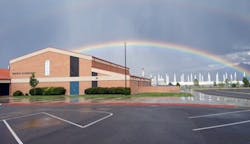Utah urges school districts to check drinking water for lead contamination
Utah officials have asked public school systems in the state to test their drinking water for lead contamination after spot tests over the summer found high levels of lead at several schools.
The Salt Lake Tribune reports that of the 188 schools sampled this spring and summer, drinking water at 10 schools contained lead concentrations that exceeded guidelines established by the U.S. Environmental Protection Agency, set at 15 micrograms per liter.
Overall, water collected from the 188 schools was nearly twice as likely to exceed the EPA’s thresholds compared with more routine samples collected from homes, prompting officials to recommend testing for all Utah schools.
“These results show that we should look,” says Marie Owens, director of the state Division of Drinking Water. “Children are a vulnerable population, and they’re at school longer than they are at home, so we should look.”
Exposure to lead can cause developmental delays in young children.
The state hopes to test as many as 900 school statewide, but the Division of Drinking Water has no legal authority to require the tests, Owens says. The division is offering technical assistance with sampling and testing, and so far, none of the schools asked to participate has refused.
Seven of the ten schools that have exceeded the federal limit so far are in the Granite School District, one of the first to agree to conduct the tests. They are Beehive Elementary; Calvin S. Elementary; Gerald Wright Elementary; Granite Technical Institute; Magna Elementary; Silver Hills Elementary; and William Penn Elementary.
District spokesman Ben Horsley says the problems have been or will be addressed before school starts next week.
“We have some of the oldest buildings on average in the state, which means older piping systems and older faucets that tend to lend themselves to a variety of issues,” Horsley says. “Over half of our buildings are over 50 years old, and frankly that is where you see a lot of those kinds of issues.
About the Author
Mike Kennedy
Senior Editor
Mike Kennedy, senior editor, has written for AS&U on a wide range of educational issues since 1999.
